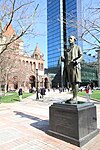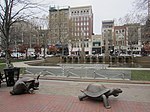John Hancock Building
Landmarks in Back Bay, BostonLandmarks in Financial District, BostonOffice buildings in Boston
Four buildings in Boston, Massachusetts, have been known as the "John Hancock Building". All were built by the John Hancock Insurance companies. References to the John Hancock building usually refer to the 60-story, sleek glass building on Clarendon Street also known as the John Hancock Tower or Hancock Place.
Excerpt from the Wikipedia article John Hancock Building (License: CC BY-SA 3.0, Authors).John Hancock Building
Trinity Place, Boston Back Bay
Geographical coordinates (GPS) Address Website Nearby Places Show on map
Geographical coordinates (GPS)
| Latitude | Longitude |
|---|---|
| N 42.348394444444 ° | E -71.075019444444 ° |
Address
Raffles Boston Back Bay Hotel & Residences
Trinity Place 40
02116 Boston, Back Bay
Massachusetts, United States
Open on Google Maps









